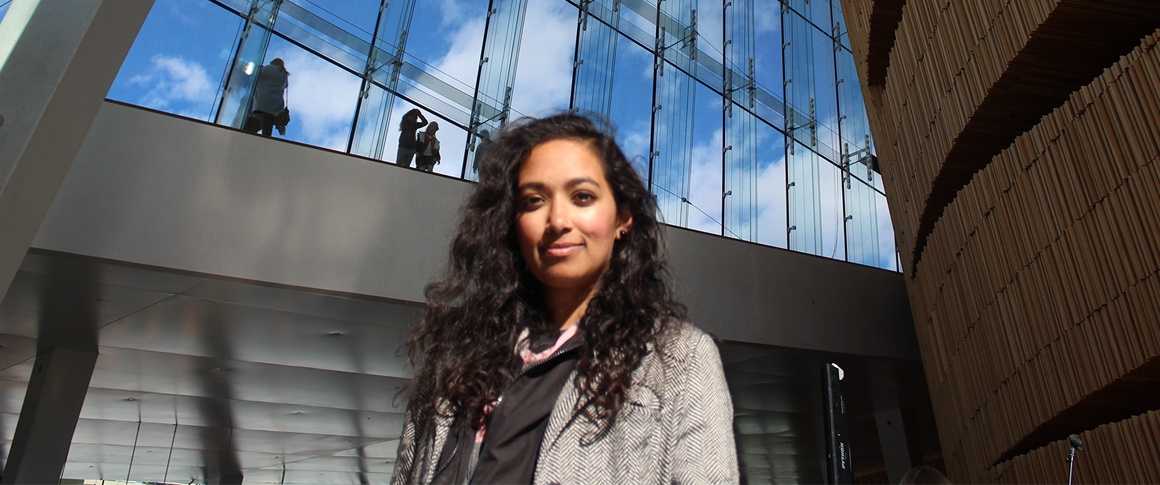Recently licensed architect Farah Ahmad, RA, LEED AP BD+C, talks about navigating the path to licensure, her experience as a minority in the architecture profession, and working in the public sector.
Why did you want to become an architect?
My father, an engineering and construction project management professional, exposed me to construction sites and “Take Your Daughter to Work” days at his office from a young age. Several years later, at age 12, the construction of my family’s vacation home in Pennsylvania afforded weekend visits to observe various planning and construction development stages. The dynamic progression of one project from conception to completion was captivating! These childhood memories—coupled with my education at Staten Island Technical High School, which offered architecture and engineering studies, and my participation in the ACE Mentor Program, designed for high school students interested in the building industry—propelled me to advance my interest in architecture.
How long did it take you to complete your experience and exams, and what was the process like for you?
It took me exactly two and a half years to complete the exams. I always felt the need to “over-study” and only scheduled exams after months of preparation in order to boost my confidence on exam day. However, I started documenting work experience much earlier, as a college student. My volunteer experience as president for the American Institute of Architecture Students (AIAS) chapter at The City College of New York and my design-build and public relations/communications leadership experience with the U.S. Department of Energy Solar Decathlon kickstarted my Intern Development Program (now the Architectural Experience Program) progress. Completing my work experience prior to testing turned out to be a great foundation, as it enabled me to understand more concepts. Overall, it was a difficult but immensely rewarding process. At the end, I gained a more comprehensive understanding of not only architectural design, but building systems and construction. I also found that studying increased my technical skills at work! For instance, my daily review of building systems was enhanced by exam topics such as mechanical, electrical, and plumbing systems.
Do you have any study secrets or advice on staying motivated?

Prep for the ARE With NCARB’s Free Practice Exams
Studying for the ARE? Use NCARB’s six free practice exams—one full-length exam per division—to prepare. You can access the practice exams in the “exam” section of your NCARB Record.
Staying disciplined with a routine schedule makes allocating studying time feel as normal as going to work. Working full-time during the week was mentally draining for long study sessions, so I allocated weekends for bulk reading. I utilized weekdays for practice questions that I could squeeze in during my commute, lunch hour, and weekday evenings. I often sacrificed time with family and friends, but would reward myself to stay motivated: planning vacations to look forward to kept my spirits up! I also made use of the expertise around me. I asked colleagues questions about building code and turned to my dad about construction methodologies or HVAC systems I couldn’t fully grasp. This made my study experience a holistic experience: I wasn’t studying just to pass an exam, but to become a well-rounded architect. Another tip I would offer is not to be discouraged by exam retakes, and to keep moving forward. Any opportunity to take the exam is incredibly insightful.
As a woman and a Pakistani American Muslim, you are a member of several underrepresented groups in the architecture field. What has that experience been like for you, and how do you think the architecture profession can improve diversity?
Fortunately, I haven’t experienced any discrimination working in the public sector. My colleagues have always been supportive and respectful, and there haven’t been any personal setbacks. However, I do recognize the lack of diversity in my profession, and consequently, have made an effort to share the story of my licensure journey to minority students and emerging professionals alike—from start (selecting a program accredited by the National Architectural Accrediting Board) to finish (documenting work experience and pacing oneself for the exams). I want to encourage underrepresented demographics to pursue STEM opportunities and take the additional steps to become licensed. We also need to increase the number of students pursuing architecture in college. By mentoring high school students and demystifying the profession, we can allow students to increase their skill set earlier and set them on the direct path for licensure.
How has becoming licensed impacted your career?
My employer recognized the value of my license and I received an instant promotion. Not only that, but I now have more work opportunities available as a registered architect. My license also creates more credential for future goals: I look forward to publishing and lecturing with this new designation in an effort to educate the public on building energy efficiency, with more credibility behind my name. Finishing the licensure process in my twenties has allowed me to move on with my life and exercise the freedom to pursue extracurriculars that build my future: I am looking forward to eco-travel experiences, volunteering, attending conferences, and getting hands-on with energy engineering!
You’re dedicated to creating energy-efficient buildings. What brought you to that specific area?
As a college student, the Department of Energy’s Solar Decathlon competition created an interdisciplinary movement: I saw firsthand the creative architectural and engineering solutions that can reduce fossil fuel consumption and alleviate excessive power grid loads. Moreover, the Decathlon competition saw the emergence of a self-sufficient community in Washington, DC: the Solar Decathlon village, a group of 20 homes. If university students could harvest natural resources into a sustainable solution on a micro-level, why couldn’t we accelerate this movement on a larger scale? Additionally, as a New Yorker, I have seen the consequences of climate change. Superstorm Sandy hit New York City hard. Architects have a responsibility to design sustaining, resilient architecture. This is inherent to creating structures that utilize resources wisely. I am dedicated to this renewable energy movement and connecting individuals who have the same mission.
You decided to pursue a career as an architect in the public sector. How has this experience been for you?
I have found my work experiences at New York City government agencies to have been personally fulfilling. I am able to utilize my technical background and merge it with advocacy. I’ll continue fighting in the battle against climate change and pressing for the social role of architects in this larger context! Working for the public also allows me to review a large portfolio of work. In my current role as a building energy code official at the New York City Department of Buildings, I am able to recognize industry trends and understand how we can improve our local laws for building emissions reduction.
Farah Ahmad is a Sustainability professional in architecture based in New York City. You can see more of her work on her website, and follow her on X and Instagram.
